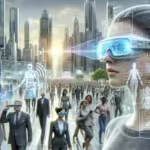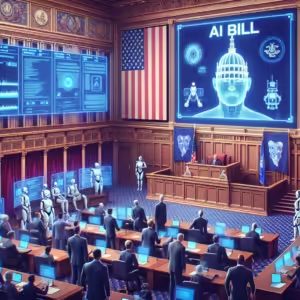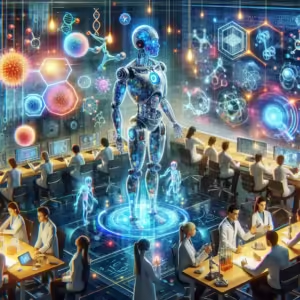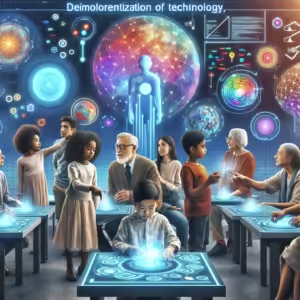The Revolutionary Impact of AI on Visual Impairment
The advancements in artificial intelligence (AI) have brought about transformational changes in various sectors. Among these changes, one of the most heartening developments is the use of AI technology to empower individuals with visual impairments. This initiative not only enhances accessibility but also enriches the lives of those who are visually impaired by offering them tools to explore and interact with the world in unprecedented ways. A particularly promising innovation in this field is emerging from the realm of Chinese scientific research.
Innovative Technology: A New Vision for the Visually Impaired
Chinese scientists have been at the forefront of leveraging AI technology to aid the visually impaired. These pioneering efforts revolve around cutting-edge applications that can fundamentally change how visually impaired individuals navigate their environments. What makes this development so impactful are the following key contributions:
- Real-Time Object Recognition: Advanced AI algorithms are now integrated into devices, allowing for the real-time identification of objects. This capability enables users to move around unfamiliar areas with greater ease and independence.
- Accessibility Through Conversational AI: AI-powered virtual assistants can describe scenes, read text out loud, or provide auditory feedback, enabling visually impaired individuals to interact with their surroundings more naturally.
- Smart Glasses and Wearables: Equipped with AI, these devices assist users by offering audio descriptions of their surroundings, aiding in navigation, and offering immediate accessibility features that enhance daily life.
The Role of Chinese Scientists in Enhancing AI Accessibility
Chinese researchers are making significant strides in turning AI-driven accessibility into a reality for the visually impaired. Their efforts focus on creating solutions that are not only technically advanced but also user-friendly and affordable. Enhancements in AI applications for the visually impaired can largely be attributed to several research and development strategies:
- Partnerships with Tech Companies: Collaboration with prominent tech firms has enabled researchers to leverage existing technologies and integrate novel AI functionalities to enhance the accessibility tools.
- User-Centered Design Approach: By actively involving visually impaired individuals in the developmental process, innovations are tailored to actual user needs, ensuring high adaptability and satisfaction.
- Commitment to Open Source Platforms: To maximize inclusivity, there is a strong emphasis on making AI applications accessible through open-source platforms, fostering innovation and community contribution worldwide.
AI Applications Changing Daily Life for the Visually Impaired
The real-world applications of AI technology are already resulting in tangible improvements for visually impaired individuals. Many tools and devices directly affect how these individuals manage day-to-day tasks:
- Navigation Apps: These AI-powered apps provide turn-by-turn audio guidance, effectively serving as a digital cane that can identify and communicate the presence of obstacles.
- Visual Interpreters: Through smartphone applications, users can take pictures of text or their surroundings, which the AI then converts into speech, enhancing reading capabilities and environmental awareness.
- Facial Recognition Tools: With AI, these tools not only recognize familiar faces but can also identify emotional expressions, providing an additional layer of social understanding and interaction.
The Broader Implications of AI Technology for Accessibility
The deployment of AI for visual impairment extends beyond immediate day-to-day assistance. It opens up new possibilities for education, workforce integration, and social interaction. The broader implications include:
- Educational Opportunities: AI tools support educational inclusivity by enabling access to a wide array of learning platforms and resources tailored for visually impaired students.
- Employment Potential: With enhanced accessibility, individuals can participate in more work settings, opening doors to diverse career opportunities and reducing unemployment rates among the visually impaired community.
- Enhanced Social Engagement: By reducing barriers, AI fosters deeper and more meaningful social interactions and community involvement, enhancing quality of life.
The Future of AI-Powered Accessibility
The journey of AI in enhancing accessibility for the visually impaired is just beginning. With continuous technological advancements, the future holds even more promising developments such as:
- More Personalized AI Assistants: Future innovations may include highly personalized AI assistants capable of adapting to users’ preferences and learning styles, offering even more effective support.
- Integration with Other Emerging Technologies: The fusion of AI with augmented and virtual reality technologies could offer immersive experiences and aid unprecedented in scope.
- Greater Global Collaboration: Expanding international partnerships can accelerate AI advances and distribute them more widely to ensure that innovations have the broadest possible impact.
In conclusion, the power of AI in assisting the visually impaired is a testament to technology’s potential to improve human lives. As researchers, particularly those in China, continue to push boundaries, the dream of a fully accessible world comes closer to reality. These advancements not only enrich the lives of those with visual impairments but also contribute to a more inclusive society where everyone has equal opportunities to explore and experience the world. The synergy between tech innovation and visionary research continues to transform the vision of a barrier-free world into an achievable future.








